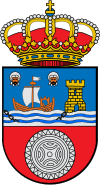

Cantabria is one of the sixteen autonomous communities of Spain. It is divided into 102 municipalities, in accordance with the organizations of territories put forth in Article 137 of the 1978 Constitution of Spain:
The state is territorially organized in municipalities, in provinces, and in the autonomous communities that constitute them. All of these entities enjoy autonomy for management of their respective interests.
— Spanish Constitution of 1978, Title VIII, Article 137.[1]
Municipal boundaries are defined in Spain's Ley Reguladora de las Bases del Régimen Local. These include "the basic local entity of the territorial organization of the state", with "legal status and full capability for the completion of their ends" and their elements are "the territory, the population, and the organization".[2]
The administration and the governance of municipalities proceeds from a low level organ termed the local government or mayoralty, which is headed by a single person: an alcalde. Until 2011, the municipalities of Tresviso and Pesquera had been governed through a direct democratic system, but with the change in the law, both abandoned this system in order to adopt representative government forms that use a mayor-council system.[3][4]
In general, municipalities are subdivided into various localities, one of which serves as the municipal seat and usually plays host to the town hall. Some municipalities take the name of one of their localities—be it their municipal seat or not—while others contain a name distinct from any of the localities therein. There also exist other sub-municipal government organs that enjoy some extent of autonomy in their management. These are called minor local entities, which correspond to villages, parishes, or districts, whose representation resides in a neighborhood board.[5] Each of these entities has a municipal code composed of five or six numbers; the first two correspond to the provincial code, while the next three numbers refer to the municipality within the particular province. The sixth and final number is a check digit that is used in order to identify errors.[6]
One should note that the Community of Campoo-Cabuérniga does not constitute a municipality per se, but rather is a sui generis territorial entity within Cantabria. Due to its unique size and makeup, the management of the locale is shared between the surrounding municipalities of Hermandad de Campoo de Suso, Cabuérniga, Los Tojos, and Ruente.[7]
- ^ "Constitución española de 1978: Título VIII. De la Organización Territorial del Estado". Wikisource. Archived from the original on 20 September 2015. Retrieved 4 November 2015.
- ^ "Ley 7/1985, de 2 de abril, reguladora de las Bases del Régimen Local. Art. 11". Noticias Jurídicas. Archived from the original on 29 October 2020. Retrieved 5 December 2018.
- ^ Cuesta, Irma (3 March 2011). "Los concejos son historia". El Diario Montañés. Archived from the original on 2 April 2021. Retrieved 5 December 2018.
- ^ San Gabriel, Diegu (27 March 2011). "La nueva ley electoral española disuelve los últimos concejos abiertos". Briega. Archived from the original on 4 March 2016. Retrieved 4 November 2015.
- ^ "Ley 6/1994, de 19 de mayo, reguladora de las Entidades Locales Menores". Boletín Oficial del Estado (162). Gobierno de Cantabria: 21910–21915. 8 July 1994. Archived from the original on 9 August 2020. Retrieved 28 August 2018.
- ^ "Relación de municipios, provincias, comunidades y ciudades autónomas y sus códigos". Instituto Nacional de Estadística (España) (in Spanish). Archived from the original on 2 November 2018. Retrieved 29 August 2018.
- ^ "Asociación y Comunidad de Campoo - Cabuérniga". administracionlocal.cantabria.es. 12 March 2012. Archived from the original on 27 December 2013. Retrieved 4 November 2015.